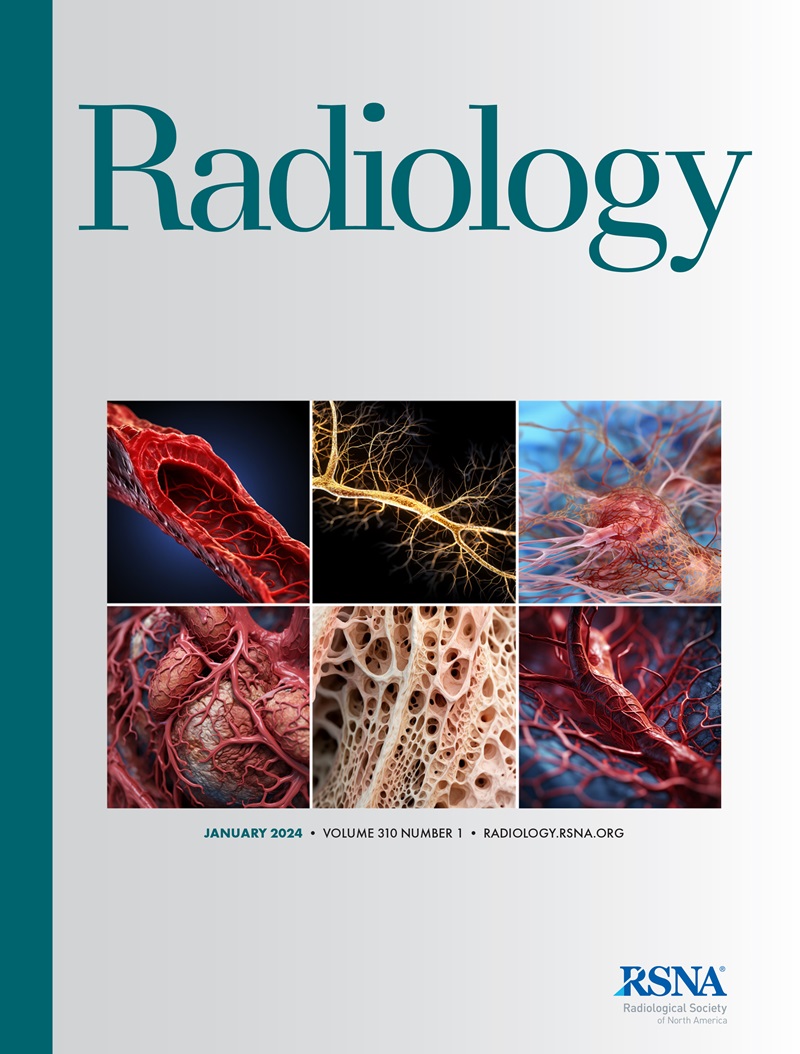Performance of Supplemental US Screening in Women with Dense Breasts and Varying Breast Cancer Risk: Results from the Breast Cancer Surveillance Consortium.
Brian L Sprague, Laura Ichikawa, Joanna Eavey, Kathryn P Lowry, Garth H Rauscher, Ellen S O'Meara, Diana L Miglioretti, Janie M Lee, Natasha K Stout, Sally D Herschorn, Hannah Perry, Donald L Weaver, Karla Kerlikowske
下载PDF
{"title":"Performance of Supplemental US Screening in Women with Dense Breasts and Varying Breast Cancer Risk: Results from the Breast Cancer Surveillance Consortium.","authors":"Brian L Sprague, Laura Ichikawa, Joanna Eavey, Kathryn P Lowry, Garth H Rauscher, Ellen S O'Meara, Diana L Miglioretti, Janie M Lee, Natasha K Stout, Sally D Herschorn, Hannah Perry, Donald L Weaver, Karla Kerlikowske","doi":"10.1148/radiol.232380","DOIUrl":null,"url":null,"abstract":"<p><p>Background It is unclear whether breast US screening outcomes for women with dense breasts vary with levels of breast cancer risk. Purpose To evaluate US screening outcomes for female patients with dense breasts and different estimated breast cancer risk levels. Materials and Methods This retrospective observational study used data from US screening examinations in female patients with heterogeneously or extremely dense breasts conducted from January 2014 to October 2020 at 24 radiology facilities within three Breast Cancer Surveillance Consortium (BCSC) registries. The primary outcomes were the cancer detection rate, false-positive biopsy recommendation rate, and positive predictive value of biopsies performed (PPV3). Risk classification of participants was performed using established BCSC risk prediction models of estimated 6-year advanced breast cancer risk and 5-year invasive breast cancer risk. Differences in high- versus low- or average-risk categories were assessed using a generalized linear model. Results In total, 34 791 US screening examinations from 26 489 female patients (mean age at screening, 53.9 years ± 9.0 [SD]) were included. The overall cancer detection rate per 1000 examinations was 2.0 (95% CI: 1.6, 2.4) and was higher in patients with high versus low or average risk of 6-year advanced breast cancer (5.5 [95% CI: 3.5, 8.6] vs 1.3 [95% CI: 1.0, 1.8], respectively; <i>P</i> = .003). The overall false-positive biopsy recommendation rate per 1000 examinations was 29.6 (95% CI: 22.6, 38.6) and was higher in patients with high versus low or average 6-year advanced breast cancer risk (37.0 [95% CI: 28.2, 48.4] vs 28.1 [95% CI: 20.9, 37.8], respectively; <i>P</i> = .04). The overall PPV3 was 6.9% (67 of 975; 95% CI: 5.3, 8.9) and was higher in patients with high versus low or average 6-year advanced cancer risk (15.0% [15 of 100; 95% CI: 9.9, 22.2] vs 4.9% [30 of 615; 95% CI: 3.3, 7.2]; <i>P</i> = .01). Similar patterns in outcomes were observed by 5-year invasive breast cancer risk. Conclusion The cancer detection rate and PPV3 of supplemental US screening increased with the estimated risk of advanced and invasive breast cancer. © RSNA, 2024 <i>Supplemental material is available for this article.</i> See also the editorial by Helbich and Kapetas in this issue.</p>","PeriodicalId":20896,"journal":{"name":"Radiology","volume":null,"pages":null},"PeriodicalIF":12.1000,"publicationDate":"2024-08-01","publicationTypes":"Journal Article","fieldsOfStudy":null,"isOpenAccess":false,"openAccessPdf":"https://www.ncbi.nlm.nih.gov/pmc/articles/PMC11366666/pdf/","citationCount":"0","resultStr":null,"platform":"Semanticscholar","paperid":null,"PeriodicalName":"Radiology","FirstCategoryId":"3","ListUrlMain":"https://doi.org/10.1148/radiol.232380","RegionNum":1,"RegionCategory":"医学","ArticlePicture":[],"TitleCN":null,"AbstractTextCN":null,"PMCID":null,"EPubDate":"","PubModel":"","JCR":"Q1","JCRName":"RADIOLOGY, NUCLEAR MEDICINE & MEDICAL IMAGING","Score":null,"Total":0}
引用次数: 0
引用
批量引用
Abstract
Background It is unclear whether breast US screening outcomes for women with dense breasts vary with levels of breast cancer risk. Purpose To evaluate US screening outcomes for female patients with dense breasts and different estimated breast cancer risk levels. Materials and Methods This retrospective observational study used data from US screening examinations in female patients with heterogeneously or extremely dense breasts conducted from January 2014 to October 2020 at 24 radiology facilities within three Breast Cancer Surveillance Consortium (BCSC) registries. The primary outcomes were the cancer detection rate, false-positive biopsy recommendation rate, and positive predictive value of biopsies performed (PPV3). Risk classification of participants was performed using established BCSC risk prediction models of estimated 6-year advanced breast cancer risk and 5-year invasive breast cancer risk. Differences in high- versus low- or average-risk categories were assessed using a generalized linear model. Results In total, 34 791 US screening examinations from 26 489 female patients (mean age at screening, 53.9 years ± 9.0 [SD]) were included. The overall cancer detection rate per 1000 examinations was 2.0 (95% CI: 1.6, 2.4) and was higher in patients with high versus low or average risk of 6-year advanced breast cancer (5.5 [95% CI: 3.5, 8.6] vs 1.3 [95% CI: 1.0, 1.8], respectively; P = .003). The overall false-positive biopsy recommendation rate per 1000 examinations was 29.6 (95% CI: 22.6, 38.6) and was higher in patients with high versus low or average 6-year advanced breast cancer risk (37.0 [95% CI: 28.2, 48.4] vs 28.1 [95% CI: 20.9, 37.8], respectively; P = .04). The overall PPV3 was 6.9% (67 of 975; 95% CI: 5.3, 8.9) and was higher in patients with high versus low or average 6-year advanced cancer risk (15.0% [15 of 100; 95% CI: 9.9, 22.2] vs 4.9% [30 of 615; 95% CI: 3.3, 7.2]; P = .01). Similar patterns in outcomes were observed by 5-year invasive breast cancer risk. Conclusion The cancer detection rate and PPV3 of supplemental US screening increased with the estimated risk of advanced and invasive breast cancer. © RSNA, 2024 Supplemental material is available for this article. See also the editorial by Helbich and Kapetas in this issue.
乳房致密且乳腺癌风险各异的女性接受美国辅助筛查的效果:乳腺癌监测联盟的结果。
背景 目前尚不清楚致密乳房女性的乳腺 US 筛查结果是否随乳腺癌风险水平而变化。目的 评估致密乳房和不同估计乳腺癌风险水平女性患者的 US 筛查结果。材料和方法 这项回顾性观察研究使用了异质性或极致密乳房女性患者在 2014 年 1 月至 2020 年 10 月期间在三个乳腺癌监测联盟(BCSC)登记处内的 24 家放射科机构进行的 US 筛查检查数据。主要结果是癌症检出率、假阳性活检建议率和活检阳性预测值(PPV3)。采用 BCSC 已建立的 6 年晚期乳腺癌风险和 5 年浸润性乳腺癌风险预测模型对参与者进行风险分类。使用广义线性模型评估了高风险与低风险或平均风险类别的差异。结果 共纳入了来自 26 489 名女性患者(筛查时平均年龄为 53.9 岁 ± 9.0 [SD])的 34 791 次美国筛查。每 1000 例检查的癌症总检出率为 2.0(95% CI:1.6,2.4),6 年晚期乳腺癌高风险患者的检出率高于低风险或平均风险患者(分别为 5.5 [95% CI:3.5,8.6] vs 1.3 [95% CI:1.0,1.8];P = .003)。每 1000 例检查中的总体假阳性活检建议率为 29.6(95% CI:22.6, 38.6),6 年晚期乳腺癌高风险患者高于低风险或平均风险患者(分别为 37.0 [95% CI:28.2, 48.4] vs 28.1 [95% CI:20.9, 37.8];P = .04)。总体 PPV3 为 6.9%(975 例中有 67 例;95% CI:5.3, 8.9),6 年晚期癌症高风险患者的 PPV3 要高于低风险或平均风险患者(15.0% [100 例中有 15 例;95% CI:9.9, 22.2] vs 4.9% [615 例中有 30 例;95% CI:3.3, 7.2];P = .01)。根据 5 年浸润性乳腺癌风险也观察到了类似的结果模式。结论 美国补充筛查的癌症检出率和 PPV3 随晚期和浸润性乳腺癌估计风险的增加而增加。RSNA, 2024 这篇文章有补充材料。另请参阅 Helbich 和 Kapetas 在本期发表的社论。
本文章由计算机程序翻译,如有差异,请以英文原文为准。


